Telyn laid her first egg of the season on Saturday, 16th April, at 15:48.
This is Telyn's fifth year of successfully breeding at this nest, equalling Glesni's 5-year reign as the Queen of the Dyfi.
Telyn laid her first egg of the season on Saturday, 16th April, at 15:48.
This is Telyn's fifth year of successfully breeding at this nest, equalling Glesni's 5-year reign as the Queen of the Dyfi.
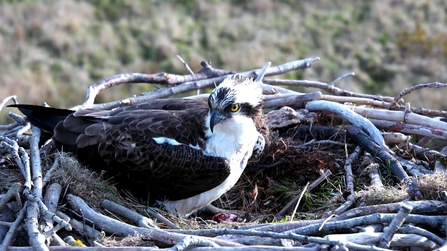
Idris. © MWT
A newly hatched brood of chicks (generally) have a better chance of survival if they all hatch close together in time.
But it takes three days for a female osprey to produce an egg, meaning there would be a six day difference between chick 1 and chick 3. That means a substantial advantage for one offspring and a disadvantageous runt-like status for the youngest.
Ospreys can't beat the laws of Biology, but they can cheat a little.
Each successive egg is a little smaller and lighter than the previous one. This foreshortens the development (incubation) time, narrowing the brood hatching window.
The first egg of a clutch will be larger than subsequent ones.
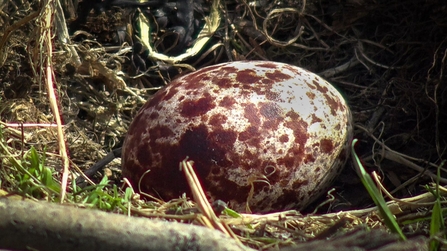
Female ospreys can also stifle - or even completely delay - the development of the first chick by not incubating the egg all the time for the first day or two.
Not tonight, Josephine
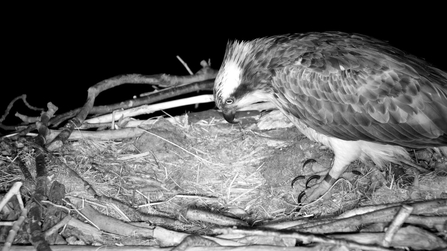
Telyn. © MWT
Telyn took several 'breaks' last night, ranging from a few minutes, to 40 minutes to over 2.5 hours, leaving her newly laid egg completely un-incubated during these periods.
This further helps chick synchronisation, ensuring the brood gets the best possible chance of survival in another six weeks or so.
Telyn was never far away though, perching just a few inches away on the nest perch - there are plenty of barn owls around looking for a free meal.
Telyn is ever watchful..
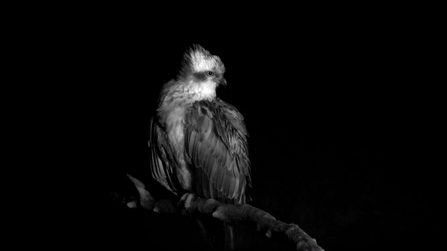
Telyn. © MWT
Do ospreys retrieve dropped fish?
Millions of years' worth of evolutionary adaptions have afforded ospreys several advantages over other raptors when it comes to holding their prey.
Small spiky skin pads called 'spicules' on the underside of the toes help to grab fish, as do backwards-facing scales on the talons which act as fish-grabbing barbs.
Ospreys can even reverse their outer toe (zygodactyl toe arrangement), enabling them to have two toes each side of the fish like a biological fairground grab-claw.
Despite these adaptions, the odd fish does go overboard now and again - as did this mullet caught by Idris yesterday. No sooner had he passed it over to Telyn, she dropped it.
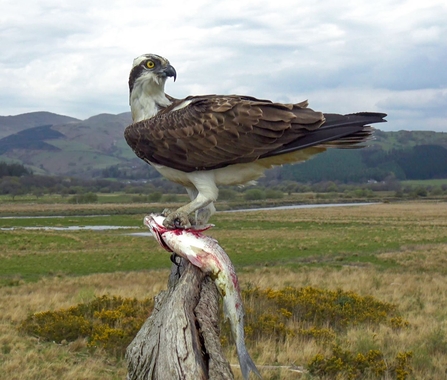
Idris. © MWT

Sometimes ospreys will retrieve their dinner, sometimes not. Neither Telyn nor Idris decided to pick up this mullet yesterday.
Here's a video of Monty dropping his fish - and then retrieving it!
Still miss you Monts
© MWT
Here's what is happening inside Telyn's body right now. We have one anthro explanation and one for the anti-anthros:
1. This afternoon we're eggspecting Egg No 2 to be laid. Soon it will be be passed to the paint shop department in the egg factory before the ink is sprayed on; we call this Splodgology. Soon after Telyn will plop out her second egg, around three days after the first one.
2. The production of Telyn's egg is almost complete, it takes around 70 hours.
The egg will have been maculated with two main pigments: Biliverdin and (mostly) Protoporphyrin to give it camouflage properties, helping it be more cryptic to aerial and other predators.
Soon the egg will receive a thin membrane called the cuticle - or 'bloom'. As the egg is passed from the uterus, this final protein coating helps the egg transport smoothly through the cloaca, just before it is laid.
Egg Anatomy
